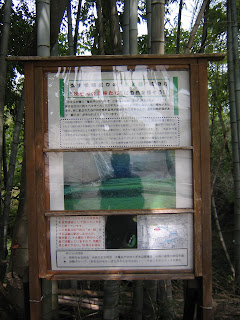In
contrast to the South Exit, the North Exit of Yayoidai Station of Sotetsu Line
is very quiet. The first impression I had there was, it was a middle of
ordinary residential area with detached houses. Coming to this direction, we
notice the Station is on the top of small hill, and the roads from there are descending.
To go to Shinbashi Citizen Forest 新橋市民の森, we have to take the road
goes down directly to the north. Passing the Hatono-Mori-Aino-Uta-Nursery 鳩の森愛の詩保育園 on
the right, at the corner of the vehicle road curving right, there are a small
pedestrian route with a notice board, and next to it with steps going down
further. The notice board says “Stop the development of cemetery to leave water
and greenery in the North of Yayoidai Station,” with signature of Neighborhood
Associations of the area, the Nursery we’ve just passed, and the Lovers of
Waterfront and Stream of Kame-yato 亀谷戸. Hmmmm …
 |
| Going
down the steps from the Station |
 |
| The
road in front of the Station goes down. |
If we
go down the steps, we find a small stream with a promenade. Turning left along
the promenade, there are several signs explaining the names of vegetation, and
asks strollers not to trash the stream as the community is striving to restore
the environment for fireflies. Just before the pedestrian promenade meets another
vehicle road, there is a large sign for the Lovers of Waterfront and Stream which
notifies they meet every 3rd Sunday at 10:00 for the maintenance
work, along with a poster presentation for the natural environment of the area
by kids of Shinbashi Elementary School 新橋小学校. On the right of the notice
boards, there is a sign we are now at one of the entrance of Shinbashi Citizen
Forest. It takes less than 10 minutes’ walk from the station.
 |
| Promenade |
 |
| Notice
Board of the Lovers |
 |
| Poster
presentation |
 |
The
right of the boards is a trekking road into the forest.
At the mouth of this
road is, |
 |
| The
entrance sign of the Forest. |
Shinbashi
Forest is another baby Citizen Forest, opened in January 2015. It has 3.3 ha
with short trekking roads where lots of maintenance works are on-going.
Intriguingly, the Forest is consisted of 2 separate areas divided by another “forest.”
The Forest we meet first from the Station is larger. Another can be accessed by
walking along the small, and very new, cemetery-forest. When we move between
the two areas, it is obvious the division is done by the planned cemetery site by
Sengenji Temple 浅間寺 in the downtown of Yokohama. Based on a quick google search, it seems to
me they are mainly engaged in funeral service business, not proselytizing. The
monks in the city have already built a slick office building, parking lots, and
some well-manicured subdivisions which is, well, clearly different from the
natural scenery (i.e. Shinbashi Forest) surrounding the graves.
 |
| Map of
Shinbashi Forest |
 |
Seen
from the notice board from the Lovers;
to another part of the Shibashi Forest
we
have to go a narrow road on the first left
at the corner of the red house.
The
building before is the office of the cemetery. |
 |
| Cemetery |
 |
| The
construction works go on … |
 |
| The
road along the cemetery |
It
seems to me Volunteers who maintain Shinbashi Forest is another group called
themselves the Lovers of Shinbashi Citizen Forest. The accessible part of the
second part of the Forest is around a small Yato which is returning to a marsh,
and where the Lovers of the Forest have their own notice board. The news in the
board says they are a partner of Firefly Restoration Committee. I don’t know
how these groups are connected to the signatory groups of the poster asking the
stoppage of cemetery development. In any case lots of things must be going on
in Shinbashi Forest now …
 |
| Entrance
to smaller part of the Forest |
 |
| Yato
in Shibashi Forest. I guess this is Kame-Yato. |
 |
| This
part of the Forest has picnic benches. |
 |
| The
forest seen from Yato |
Aside
from humans surrounding the Forest, Shinbashi Forest is a typical of Yokohama
Citizen Forest. It is made of a steep hill and a Yato valley at the bottom. The
trees are mix of bamboos, coniferous trees, and broadleaves. When we enter from
the first entrance we meet from the Station, two trekking roads are climbing
steeply to the ridge which is the outer edge of the Forest. I found this edge
goes along the railway of Sotetsu Izumino Line to Shonandai of the City of
Fujisawa. It is really a baby Citizen Forest. We find several log piles along
the trekking road, made by volunteers doing maintenance works. The difference
between a clean 21st century cemetery construction site and here is,
the logs in the forest become the home for so many living creatures ... fungi,
insects, bushes …
 |
| Into
the forest |
 |
Those
mushrooms looked very like cloud ears
… are they? |
 |
| Here
is another mushroom. |
 |
| Majestic |
 |
| Cute |
… In
the end we are all consumed by bacteria like those logs, become a part of soil.
Maybe, the first procedure to be incorporated into the earth is the point of
contention. Even Buddhism monks could not reach to a peaceful solution for the
matter … we are so … pre-enlightenment.
If you find a problem in the Park,
please make a contact with
Office for the Park Greeneries in the
South 南部公園緑地事務所
Yokohama Municipal Government
Creative Environment Policy Bureau 横浜市環境創造局
Phone: 045-831-8484 (I guess in
Japanese only)
FAX: 045-831-9389 (I hope there is
somebody who can read English …)


























No comments:
Post a Comment